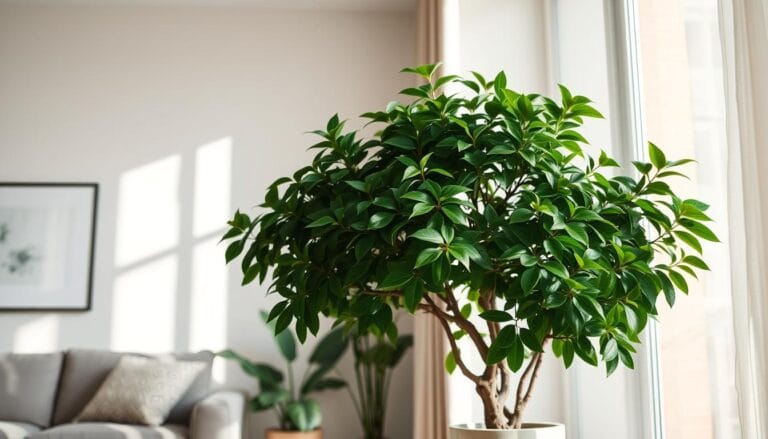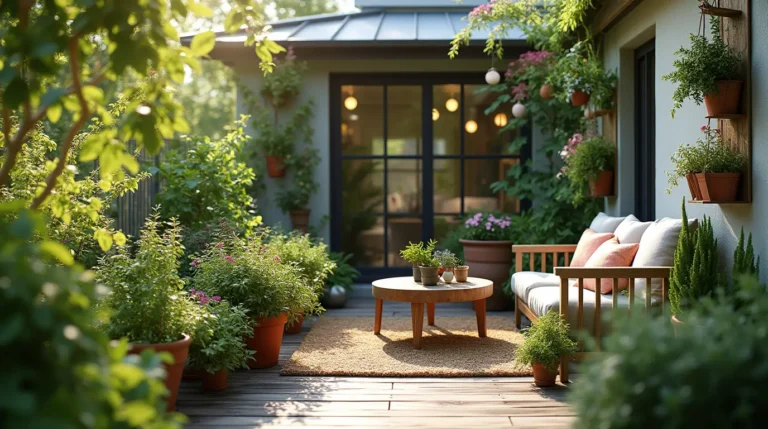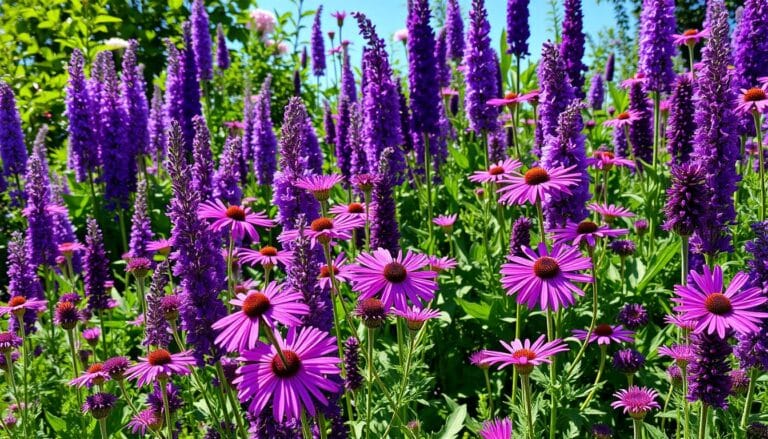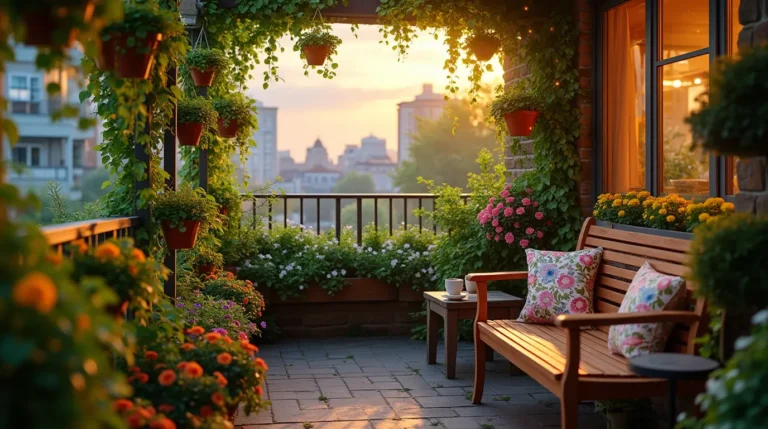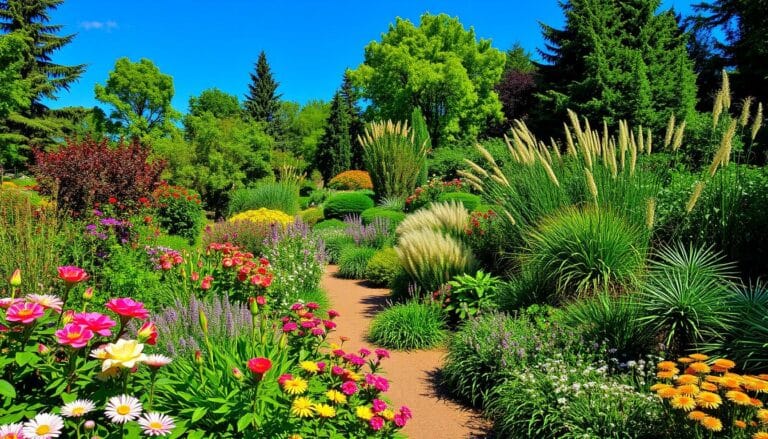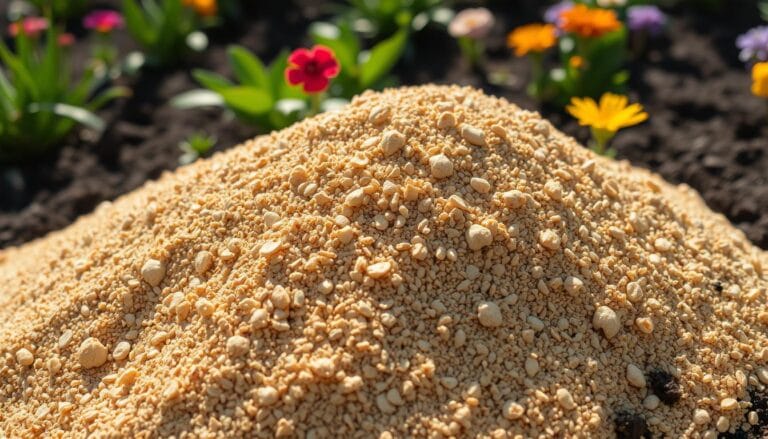Small Patio Garden: How to Grow 12 Vegetables in Limited Space

I remember my first gardening experience, growing a lima bean in a paper cup. It sparked a passion for growing my own food, even in small spaces. I found out you can grow many vegetables in just a few square feet. With the right techniques, you can have a thriving garden and enjoy fresh, homegrown produce.
A small keyhole garden can fit in an 8×8 space and produce hundreds of pounds of food. This shows that even small spaces can be very productive. By using space-saving gardening and choosing the right vegetables, your patio garden can be both beautiful and productive.
Table of Contents
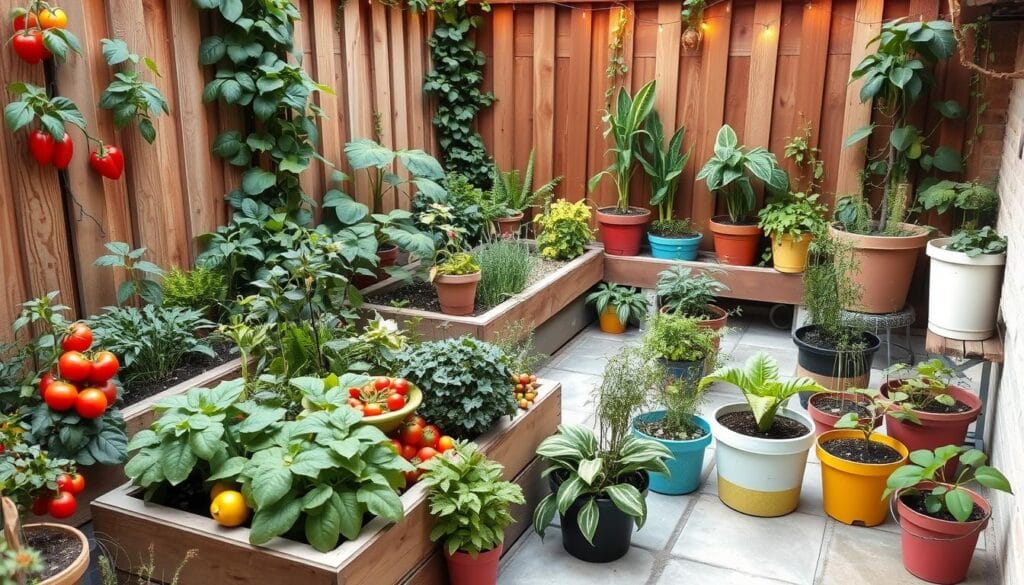
Key Takeaways
- You can grow a variety of vegetables in a small patio garden, even in limited spaces.
- Small patio garden ideas can be highly productive, with the right techniques and strategies.
- Utilizing space-efficient gardening methods, such as keyhole gardens, can help maximize your harvest.
- Selecting the right varieties of vegetables, such as compact or bush varieties, can help ensure a bountiful harvest.
- Creating a small patio garden can provide you with fresh, homegrown produce and add beauty to your outdoor space.
- With proper planning and maintenance, a small patio garden can be a thriving and sustainable source of fresh food.
Why Your Small Patio Garden Can Be a Vegetable Paradise
Many think gardening is out of reach for small patio spaces. But, with the right approach, you can grow a lush vegetable garden. Growing your own veggies saves money and brings fresh produce right to your door.
Vertical garden walls boost your planting space. They’re perfect for city folks with little room but a big desire to garden.
Benefits of Growing Your Own Vegetables
Homegrown veggies offer fresh taste, cost savings, and control over your garden. You can grow a variety, like tomatoes, peppers, and herbs like basil and mint.
Understanding Space Requirements
When planning your small patio garden, know the space each plant needs. Consider their mature size, sunlight, and water needs. Choose plants that fit your space for a thriving garden.
Setting Realistic Expectations
Be realistic about your garden’s potential. Think about your time, effort, and local climate. A realistic view helps create a garden that’s both beautiful and productive.
Essential Tools and Materials for Patio Gardening
Exploring patio gardening, I’ve learned the value of the right tools and materials. Vertical garden pots and patio garden ideas are crucial. It’s key to pick containers and materials that fit your needs and style.
Popular container materials include ceramic, terra cotta, plastic, wood, cement, and fabric. Each has its own benefits. For example, ceramic and terra cotta hold moisture well. Plastic and fabric are lighter and easier to move.
Choosing the right tools depends on your plants and maintenance needs. You’ll need a garden hose, adjustable rake, loppers, and watering wand. The hose’s length and diameter affect water pressure.
Here are some essential tools:
- Standard adjustable rakes (8-23 inches in width)
- Loppers (able to cut branches up to 2 inches in diameter)
- Watering wands (10-48 inches in length)
- Heavy-duty grow trays (up to 50 lbs weight capacity)
Quality tools and materials will help you create a vibrant patio garden. It will bring you joy and fresh produce for years.
| Tool | Description | Price Range |
|---|---|---|
| Garden Hose | Durable, kink-resistant hose for watering plants | $20-$50 |
| Adjustable Rake | Expands from 8-23 inches in width for easy leaf removal | $15-$30 |
| Loppers | Cuts branches up to 2 inches in diameter with ease | $25-$40 |
Planning Your Small Patio Garden Layout
Creating a thriving small patio garden starts with planning. I first analyze the space available, considering the patio’s size and shape. I also think about any obstacles or features that might affect the layout. This helps me figure out the best way to use the space and ensure plants get enough sunlight and water.
In a small patio garden, every inch matters. Using a vertical planter is a smart move. It can be attached to a wall or placed in a corner, giving plants plenty of room to grow. Patio gardening is all about creativity and making the most of your space, and vertical planters are a great tool for this.
After understanding my space, I start planning the garden’s layout. I think about the sunlight my patio gets and the plants I want to grow. For example, vegetables need at least 6 hours of direct sunlight a day. By mapping out the sun exposure, I can create a garden plan that suits my plants and space.
Creating a Garden Blueprint
To make a garden blueprint, I sketch out my patio, including any obstacles or features. Then, I think about the plants I want and how much space they need. Planning my garden layout helps me create a beautiful and thriving small patio garden that meets my needs and enhances my outdoor space.
Tips for Planning Your Small Patio Garden
- Start by analyzing your available space and considering any obstacles or features that may impact your garden’s layout
- Use a vertical planter to maximize your space and provide ample room for plants to grow
- Map out your sun exposure to determine the best location for your plants
- Create a garden blueprint to help you visualize your garden and make the most of your space
Choosing the Right Containers and Soil
Creating a thriving small patio garden starts with the right containers and soil. I explore small patio garden ideas and patio garden ideas to make the most of my space. With the right choices, I can grow a variety of vegetables, herbs, and fruits.
I look for containers that give my plants enough room to grow. Containers with good drainage and a depth of 6-8 inches are perfect for small plants. For bigger plants like tomatoes, I choose containers that are 18 inches or more deep. The EarthBox gardening boxes are a great option, offering different depths for various plants.
Choosing the right potting mix is also key. I avoid using regular garden soil and instead opt for a soil-less mix. This mix, made of peat moss, perlite, and vermiculite, helps with aeration, moisture, and drainage. It creates a perfect environment for my plants to flourish.
- Weekly fertilizing during the growing season
- Daily watering in hot weather, or checking moisture levels about an inch down in the potting mix
- Protection from wind to prevent drying out
- Using a soil pH between 6.2 and 6.8 for tomatoes and peppers
By following these tips and choosing the right containers and soil, I can create a thriving small patio garden. It brings fresh produce and beauty to my outdoor space. Whether I’m looking at small patio garden ideas or patio garden ideas, I know I can grow a variety of delicious and healthy plants.
| Container Type | Depth | Plant Options |
|---|---|---|
| EarthBox gardening boxes | 11 inches | Most popular vegetables |
| Herb planting boxes | 7 inches | Various herbs |
| Vegetable planting boxes | 15 inches or more | Root vegetables |
| Tomato planters | 11 inches | Tomatoes |
Vertical Garden Solutions for Maximum Space Efficiency
Exploring small patio gardens, I see how crucial space use is. Vertical garden solutions are key. A vertical garden wall can make any patio stunning. Paired with a vertical planter, it boosts space use. For instance, a stamped concrete patio can turn into a lush haven with a smart vertical garden.
Creating a vertical garden offers many choices.
Vertical Planter Options
Options include trellises, stackable planters, and hanging containers. These can hold plants like peas, pole beans, succulents, and ferns. Mixing these planters makes a unique, thriving garden that beautifies and functions your patio.
Vertical gardens also have practical benefits. They prevent soil erosion and nutrient loss. They also cut down disease risks. For those with mobility issues, vertical gardens are easier to tend. With the right plants and planters, even a small patio can bloom with life and beauty.
Some top picks for vertical gardens are:
- Peppers
- Tomatoes
- Lettuce
- Swiss chard
- Basil
- Oregano
- Rosemary
- Cilantro
Choosing the right plants and a well-designed vertical garden wall can add a stunning, functional feature to your patio. It showcases the beauty of a vertical garden on a stamped concrete patio.
Best Vegetables for Small Patio Gardens
Choosing the right vegetables is key for small patio gardens. You want to use every inch of space wisely. Compact tomatoes, peppers, and cucumbers are great choices.
These veggies need little space and grow well in containers. For instance, a single tomato can do well in a 5-10 gallon pot. Even small herb plants like basil can thrive in an 8-inch pot.
Compact Varieties
Compact varieties are made for small spaces. They produce a lot of food even in tight spots. ‘Bush Slicer’ Cucumber and ‘Pizza My Heart’ Sweet Peppers are good examples. They grow well in containers and add freshness to your garden.
High-Yield Options
High-yield options are great for small gardens because they produce a lot. Leafy greens like spinach and kale are perfect. They can be picked over and over again.
Radishes and carrots are also high-yield. You can plant them every 2-4 weeks for a steady supply.
Season-by-Season Planning
Planning your garden by season is crucial. This way, you can have fresh produce all year. In spring, plant cool-season crops like lettuce and spinach.
In summer, warm-season crops like tomatoes and peppers are best. This ensures a constant flow of fresh food.
| Season | Vegetables to Plant |
|---|---|
| Spring | Lettuce, Spinach, Radishes |
| Summer | Tomatoes, Peppers, Cucumbers |
| Fall | Broccoli, Kale, Carrots |
By picking the right veggies and planning seasonally, you can enjoy a year-round harvest.
Irrigation and Watering Systems
Small patio spaces can be tricky for gardening, including irrigation and watering. I’ve found that picking the right system is key for my plants. For my patio garden, I chose a drip irrigation system. It has tubing with holes every 12 inches to save water and keep soil moist.
I also use soaker hoses for my vertical garden wall. They give slow, deep water right to the roots, saving water. Other options include:
- Self-watering containers with a water reservoir at the bottom to reduce evaporation losses
- Mulching to reduce water evaporation and improve soil moisture retention
- Compost to improve soil texture and water retention
- Installing a rain barrel to collect and store runoff water
Watering at the right time is crucial. I water my plants in the early morning to save water and help it soak into the soil. With a timer, I can water even when I’m away. The right system keeps my plants healthy and saves water.
Natural Pest Control in Limited Spaces
Exploring small patio garden ideas, I see how vital natural pest control is. Organic gardening is becoming popular for its non-toxic pest management. In a small garden, it’s key to use natural methods to protect both plants and beneficial insects.
A healthy plant is less likely to attract pests, but it’s not foolproof. Common pests include aphids, mosquitoes, spider mites, thrips, and mealybugs. To fight these, organic solutions like neem oil, diatomaceous earth, and companion planting work well. For instance, marigolds can keep nematodes and aphids away, while ladybugs help control aphids.
For natural pest control, consider a homemade spray with onion, garlic, mint, and cayenne pepper. Use it 1-2 times a week to keep pests away. Also, a diverse garden attracts natural predators like frogs and birds, helping control pests. These methods help create a balanced, thriving garden ecosystem.
Other organic pest control options include:
- Using baking soda to fight fungal diseases
- Creating a companion planting plan to deter pests
- Introducing beneficial insects to manage pest populations
By adopting these natural pest control methods, I can keep my small patio garden healthy and balanced. This promotes a thriving ecosystem.
Maximizing Harvest in Your Small Patio Garden
To get the most out of your small patio garden, using certain techniques is key. A vertical planter is a great way to grow more plants in a small space. For example, you can use a trellis for climbing plants like peas and beans. Or, hang a planter for strawberries and cherry tomatoes.
Succession planting is another effective method. It means planting new crops every few weeks for a steady supply of fresh produce. You can also use companion planting to boost your yield. For instance, planting lettuce, basil, and onions around tomatoes can help keep pests away and increase tomato yield.
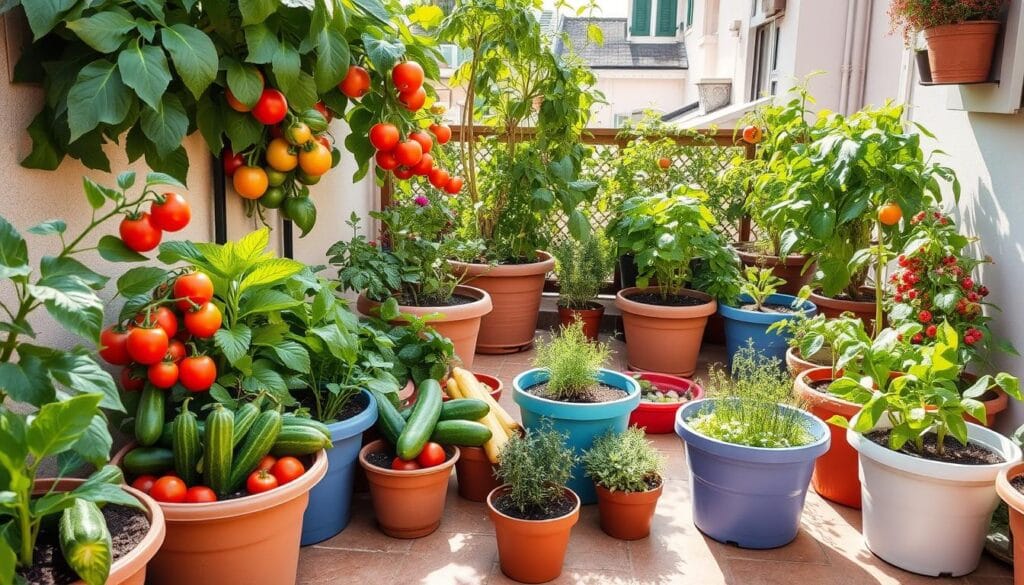
Some top vegetables for small gardens include lettuce, tomatoes, and potatoes. These plants are great for small spaces because they produce a lot of food from one plant. Using deep pots and 5-gallon pails can also help grow potatoes and carrots vertically, saving space.
By applying these techniques and picking the right plants, you can enjoy a rich harvest. Patio gardening has many benefits, like saving water and increasing yield. With the right strategies and creativity, your small patio garden can become a productive and thriving space.
Seasonal Maintenance Guide
As a small patio garden owner, I know how crucial it is to keep my garden in top shape all year. With the right small patio garden ideas, my garden stays beautiful, no matter the weather. Preparing my garden for each season is a big part of this.
In spring, I clean my patio garden ideas and get rid of winter debris. I also check my vertical garden wall for damage and fix it if needed. Summer is about keeping my garden watered and fed. Fall is for preparing it for winter with mulch and frost protection.
Other tasks I do include:
- Pruning my plants to keep them healthy and looking their best
- Inspecting my garden for any signs of pests or diseases
- Adding new plants and features to my garden to keep it looking fresh and interesting
By following these tips, my small patio garden stays beautiful all year. Whether I’m looking for small patio garden ideas, patio garden ideas, or vertical garden wall maintenance, I know my garden will flourish.
Conclusion: Growing Success in Your Compact Garden Space
As we wrap up our exploration of small patio gardens, I’m thrilled to share some final thoughts. Growing your own veggies, even in tight spaces, is incredibly rewarding. You get to enjoy fresh, tasty produce and save on grocery bills. Plus, your small patio can become a lush vegetable paradise with the right planning.
One big plus of patio gardening is controlling your food’s quality. By growing your own, you avoid harmful chemicals and pesticides. The pride and joy of harvesting your own crops is unbeatable.
To succeed with a small patio garden, start small, try new things, and be patient. With the right tools, containers, and soil, you can make the most of your space. Get creative with vertical gardening and companion planting to boost your garden’s productivity.
So, dive into urban gardening and plan your own patio vegetable haven. With a bit of care and attention, you’ll have a thriving, sustainable, and delicious garden in your outdoor space.
FAQ
What are the benefits of growing your own vegetables in a small patio garden?
Growing your own veggies in a small patio garden is rewarding. You get fresh, tasty produce right at home. It also lets you control the growing conditions and avoid harmful chemicals.
How do I choose the right containers and soil for my small patio garden?
When picking containers, think about size, material, and weight. Pick ones that fit your veggies and have good drainage. Use a top-notch potting mix or soil made for container gardens to help your plants grow well.
What are some of the best vegetables to grow in a small patio garden?
For small patio gardens, choose compact tomatoes, peppers, lettuces, radishes, herbs, and greens. These plants take up less space and work great in containers or vertical gardens.
How do I create a vertical garden to maximize my small patio space?
Vertical gardening is a smart way to use your patio space. Use hanging baskets, tiered planters, or DIY walls to grow veggies. Make sure your vertical setup can hold the weight and pick the right plants and containers.
How do I maintain my small patio garden throughout the seasons?
To keep your patio garden in top shape, water, fertilize, and watch for pests regularly. Adjust your care as the seasons change, like adding shade in summer and protecting from frost in winter. Prune and harvest often to keep your garden productive.

